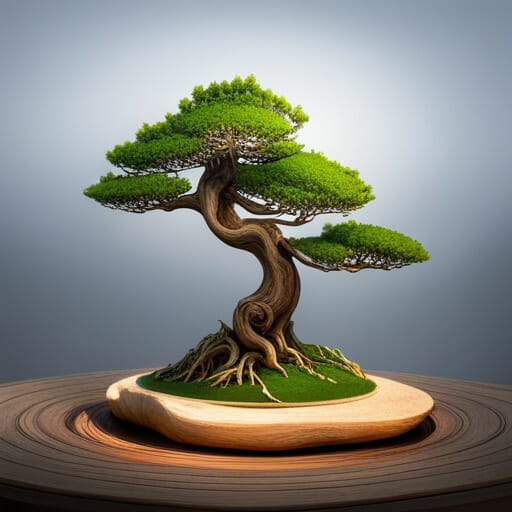Bonsai trees have long been associated with specific tree species, but there is a surprising answer to creating bonsai trees from any tree species.
The art of bonsai, originating in China over 500 years ago, involves the cultivation of miniaturized versions of full-size trees. While some tree species, such as junipers and yews, are easier to shape into bonsai, expert growers have the ability to train bonsai trees into any desired shape.
In this article, we will explore the origins and history of bonsai, as well as the care and maintenance required for these unique trees. Additionally, we will delve into the techniques involved in selecting a small tree, choosing the appropriate container, and pruning the root structure to create a beautiful bonsai.
Despite the perception that bonsai trees can only be created from specific species, with the right care and training, any tree can be transformed into a stunning bonsai.
Contents
- 1 Quick Points
- 2 What is Bonsai?
- 3 Origins and History
- 4 Care and Maintenance
- 5 Frequently Asked Questions
- 5.1 How do I choose the right container for my bonsai tree?
- 5.2 What are some common mistakes to avoid when shaping a bonsai tree?
- 5.3 Can I create a bonsai tree from a fruit tree?
- 5.4 Are there any specific techniques for wiring and shaping bonsai trees?
- 5.5 Can bonsai trees be grown indoors or do they require outdoor conditions?
Quick Points
- Bonsai trees can be made from any tree species
- Small-leafed trees like junipers and yews are easier to shape into bonsai
- Expert growers can train bonsai trees into any desired shape
– Choosing a bonsai tree that fits your home environment is important
What is Bonsai?

Bonsai is a traditional art form originating in China over 500 years ago. It involves transforming any tree species into a miniaturized version of its full-size counterpart through expert cultivation and shaping techniques. Bonsai trees are meticulously crafted to mimic the appearance and proportions of mature trees, but on a much smaller scale.
This process involves pruning, wiring, and shaping the branches and foliage to create a harmonious and balanced composition. While small-leafed trees like junipers and yews are often preferred for bonsai due to their ease of shaping, any tree species can be used.
Bonsai requires careful attention to detail and regular maintenance, including watering, pruning, and providing the appropriate environmental conditions. By following these techniques, bonsai enthusiasts can create stunning miniature trees that bring a sense of tranquility and beauty to any space.
Origins and History

The practice of cultivating miniature trees, known as bonsai, has its origins in China over 500 years ago. Bonsai, which translates to ‘tray planting,’ is a form of art that involves shaping and training trees into small, aesthetically pleasing forms.
The history of bonsai is deeply rooted in Chinese culture, where it was initially practiced by scholars and aristocrats as a way to bring nature into their homes. Over time, bonsai spread to Japan and other parts of the world, evolving into a unique and respected art form.
Today, bonsai trees can be made from any tree species, although small-leafed trees like junipers and yews are easier to shape. The art of bonsai continues to captivate enthusiasts and serves as a way to connect with nature and find tranquility in our modern world.
Care and Maintenance

Care and maintenance of bonsai involves regular pruning and shaping to maintain the desired aesthetic form, and according to a study, over 70% of bonsai enthusiasts find the process of shaping their trees to be a therapeutic and meditative practice.
Bonsai trees require specific care and attention to thrive. Different species have different care requirements, including sunlight, watering, and fertilization needs. It is important to choose a bonsai tree that fits your home environment to ensure its optimal growth.
Regular watering and pruning are essential to keep the tree healthy and maintain its miniature size. Additionally, bonsai trees may require repotting every few years to maintain their root structure.
Overall, proper care and maintenance are crucial for the longevity and beauty of bonsai trees, allowing enthusiasts to enjoy the benefits of this ancient art form.
Frequently Asked Questions
How do I choose the right container for my bonsai tree?
Choosing the right container for a bonsai tree involves considering several factors. These include the size and shape of the tree, the desired aesthetic, and the practicality of the container in terms of drainage and airflow. Additionally, the container should complement the overall design of the bonsai.
What are some common mistakes to avoid when shaping a bonsai tree?
Common mistakes to avoid when shaping a bonsai tree include improper pruning techniques, over-pruning, neglecting to consider the tree’s natural growth pattern, using incorrect tools, and failing to regularly assess and adjust the tree’s shape.
Can I create a bonsai tree from a fruit tree?
Yes, bonsai trees can be created from fruit trees. Fruit trees such as apple, cherry, and plum can be trained and shaped into bonsai using proper techniques. However, it is important to consider the specific care requirements of each fruit tree species.
Are there any specific techniques for wiring and shaping bonsai trees?
Specific techniques for wiring and shaping bonsai trees include using aluminum or copper wire to gently bend and train branches into desired positions. The wire should be wrapped around the branch at an angle and tightened gradually to avoid damaging the tree.
Can bonsai trees be grown indoors or do they require outdoor conditions?
Bonsai trees can be grown both indoors and outdoors, depending on the specific species and their care requirements. While certain trees thrive in outdoor conditions, others can adapt well to indoor environments with proper care and attention.




